
Crow is the common name for various medium to large sized birds in the genus Corvus.
They are typically distinguished from ravens by smaller size and without the raven’s shaggy throat feathers.
There are about 35 species of crow.
They are found in most parts of the world, with the exception of southern South America.
Some crows may live to the age of 20, and the oldest known American crow in the wild was almost 30 years old. The oldest documented captive crow died at age 59.
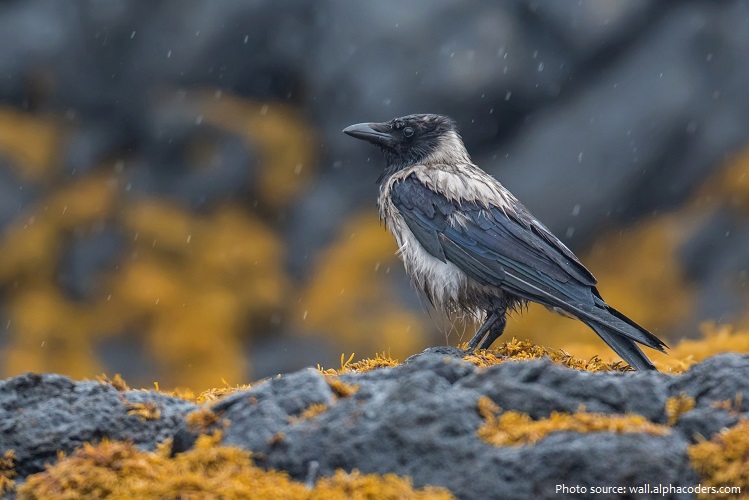
These are birds with a robust and slender appearance, equipped with a small rounded head with a strong conical beak, elongated and pointed, with a slightly curved end towards the bottom: the legs are strong and the tail is short and wedge-shaped.
The coloration of the livery is dominated by shades of black, with some species having plumage with metallic iridescences and others that have white or gray areas on the neck or torso: Australian species have light eyes, while generally the irises are dark.
Crows feed chiefly on the ground, where they walk about purposefully.
Crows are omnivorous, and their diet is very diverse. They will eat almost anything, including other birds, fruits, nuts, mollusks, earthworms, seeds, frogs, eggs, nestlings, mice, and carrion.
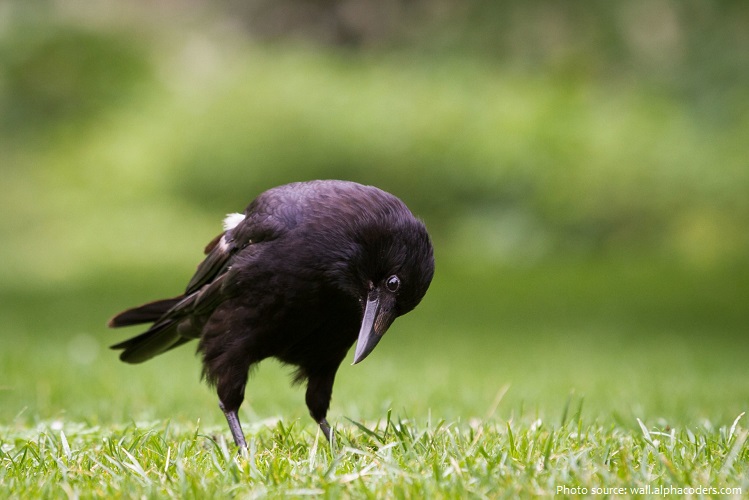
Crows will make off with shreds of roadkill and store tidbits in trees, caching the meat like a leopard does for later consumption. Sometimes they bury seeds or store them in crevices in bark. They occasionally steal food from other animals, sometimes cooperating with other crows to raid food from otters, vultures, and water birds.
The origin of placing scarecrows in grain fields resulted from the crow’s incessant damaging and scavenging, although crows assist farmers by eating insects otherwise attracted to their crops.
Crows gather in large communal roosts numbering between 200 and tens of thousands of individuals during nonbreeding months, particularly in the winter. These gatherings tend to happen near large food sources such as garbage dumps and shopping centers.
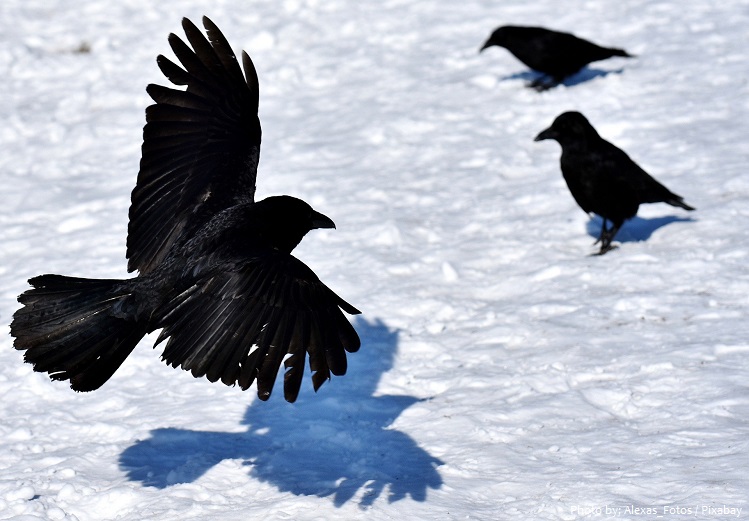
Crows live in close-knit families, and, like social mammals, they not only hunt and forage together but also defend territories and care for the young together. Most species, however, do not nest in colonies.
Each mating pair has its own nest of sticks and twigs, usually high up in a tree. There are laid five or six greenish-to-olive eggs, with darker speckles. Young crows may spend up to six years with their parents before breeding on their own.
As winter approaches, northern crows gather into large night-roosting groups. These flocks can include tens of thousands of birds and occasionally hundreds of thousands. Possible reasons for this seasonal gregariousness are warmth, protection against predators such as owls, or information exchange.

The members of the genus Corvus are believed to have evolved in Central Asia and radiated out from there into North America, Africa, Europe, and Australia.
The collective name for a group of crows is a flock or, more poetically, a murder.
Crows are now thought to be, with parrots, among the world’s most intelligent birds. They have a brain size (adjusted for body size) as large as some apes.
Highly intelligent, crows can be masterful mimics. They have been trained to count aloud up to seven, and some crows have learned more than 100 words and up to 50 complete sentences – others have been known to mimic their owners’ voices in order to call dogs and taunt horses.

They also exhibit great curiosity, fueling a reputation as inventive pranksters and calculating thieves. They fly off with people’s mail, pull clothespins off lines, and make off with unattended objects such as car keys.
Crows have demonstrated the ability to distinguish individual humans by recognizing facial features.
Evidence also suggests they are one of the few nonhuman animals, along with insects like bees or ants, capable of displacement (communication about things that are not immediately present, spatially or temporally).
New Caledonian crows are among the only animals that create their own tools. They mainly manufacture probes out of twigs and wood (and sometimes metal wire) to catch or impale larvae. Tool use in some
birds may be best exemplified in nest intricacy.
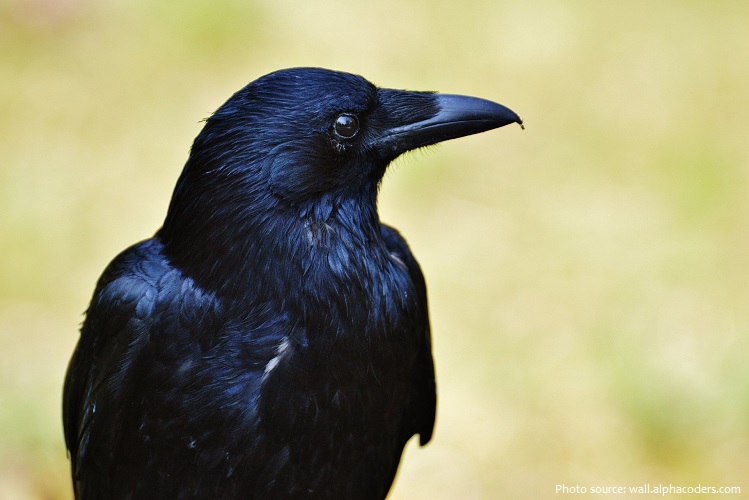
Wild hooded crows in Israel have learned to use bread crumbs for bait-fishing.
A story of how a girl fed crows, and in return they brought her tiny gifts, shows what the birds are capable of.
In medieval times, crows were thought to live abnormally long lives. They were thought to predict the future, to predict rain and reveal ambushes. Crows were also thought to lead flocks of storks while they crossed the sea to Asia.
In Australian Aboriginal mythology, Crow is a trickster, culture hero, and ancestral being. Legends relating to Crow have been observed in various Aboriginal language groups and cultures across Australia – these commonly include stories relating to Crow’s role in the theft of fire, the origin of death, and the killing of Eagle’s son.
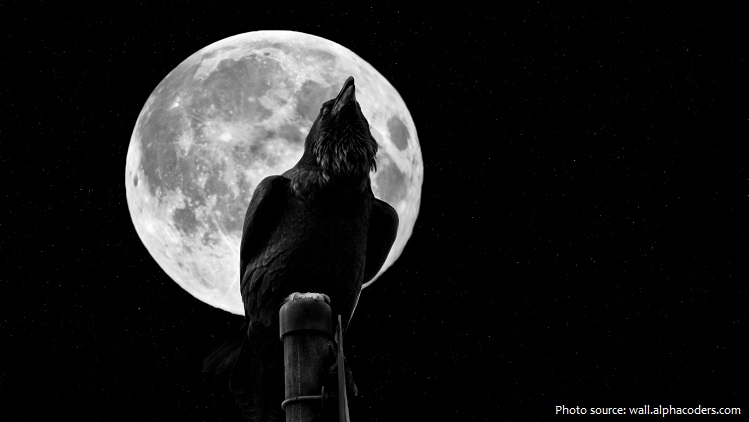
Crows are mentioned often in Buddhism, especially Tibetan disciplines. The Dharmapala (protector of the Dharma) Mahakala is represented by a crow in one of his physical/earthly forms.
In Hinduism, crows are thought of as carriers of information that give omens to people regarding their situations. For example, when a crow crows in front of a person’s house, the resident is expected to have special visitors that day. Also, in Hindu literature, crows have great memories which they use to give information.
In Hinduism Crows are believed to be connected with both the gods and goddesses, particularly the controversial ones such as sani, the god of the planet Saturn, who uses a crow as his vehicle.
Crows are associated with Dhumavati the form of mother goddess that invokes quarrel and fear.
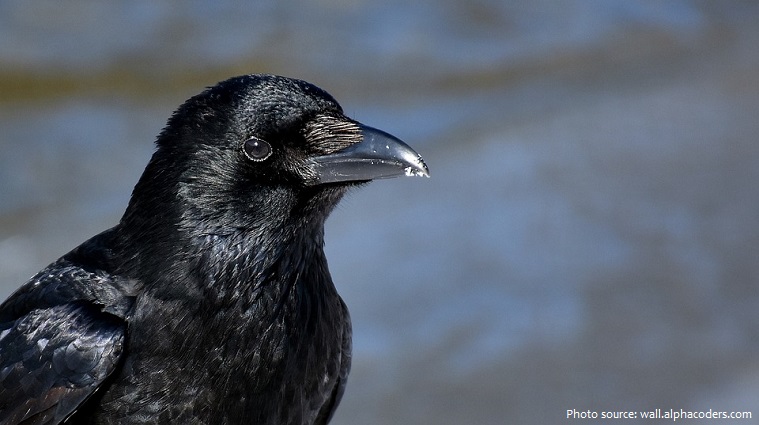
In Chinese mythology, the world originally had 10 suns either spiritually embodied as 10 crows and/or carried by 10 crows – when all 10 decided to rise at once, the effect was devastating to crops, so the gods sent their greatest archer Houyi, who shot down nine crows and spared only one.
In Irish mythology, crows are associated with Morrigan, the goddess of war and death.
J. R. R. Tolkien’s The Hobbit states that crows are agents of the evil goblins, while ravens are allies of the Dwarves.